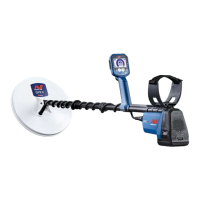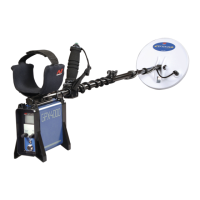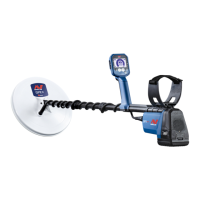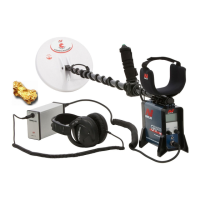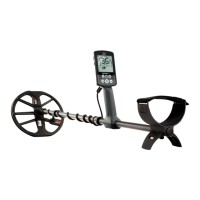Ground Balance and Tracking
Most ground contains not only sand but also many
different chemicals, minerals, and salts. These extra
materials are referred to as ground mineralisation. If
not compensated for, this ground mineralisation may
produce erratic sounds known as ‘ground noise’. This
ground noise can make it more difficult for you to
hear target signals; particularly quiet target signals
from small or deep targets.
The Ground Balance function in your GPZ 7000
detector tests for ground mineralisation and
compensates for it, thus reducing ground noise. This
ensures signals from targets, such as gold nuggets, are
not confused with ground noise.
Detector Sounds
Keypad
The detector will make a sound whenever buttons on the
keypad are pressed. A valid button press makes a short
high pitched ‘bip’ sound; an invalid button press makes a
long low pitched ‘ba dump’ sound.
Threshold
The constant background ‘hum’ produced by the detector
is called the Threshold. Variations in the Threshold allow
you to hear very small and deep targets. This is also
used to help distinguish between desired and undesired
targets. Refer to the Detect Plus section (page 25) for
information on how to correctly adjust the threshold level
and pitch.
Targets
When the coil is moved over a gold target or other metal
object, an audio signal is the sound produced by the
detector. Large targets or targets close to the ground
surface emit louder sound than smaller targets or deeply
buried targets. Targets very near to the surface may
produce a double target response.
Overload
Very large metal objects close to the coil may overload
the detector electronics. If this happens, the detector
displays an overload message and plays an alert sound
until the coil is moved away from the source of the
overload. Overloading is not harmful to the electronics of
the detector.
Electrical Noise
The detector may produce false signals (Noise) when
the coil is held motionless or in the air. These signals are
electromagnetic interference (EMI). You can minimise false
signals by performing a Noise Cancel (page 22), or by
reducing the Sensitivity of the detector (page 23). It is
generally better to try to reduce false signals by adjusting
Noise Cancel before reducing the Sensitivity.
Ground Noise
When detecting in ground with high levels of
mineralisation, movement of the detector over the ground
can produce false target signals. These unwanted target
signals are known as ground noise.
Refer to the Ground Type (page 22) and Ground Balance
Mode (page 26) for details on how to adjust your
detector to minimise ground noise.
Detecting Basics
50

